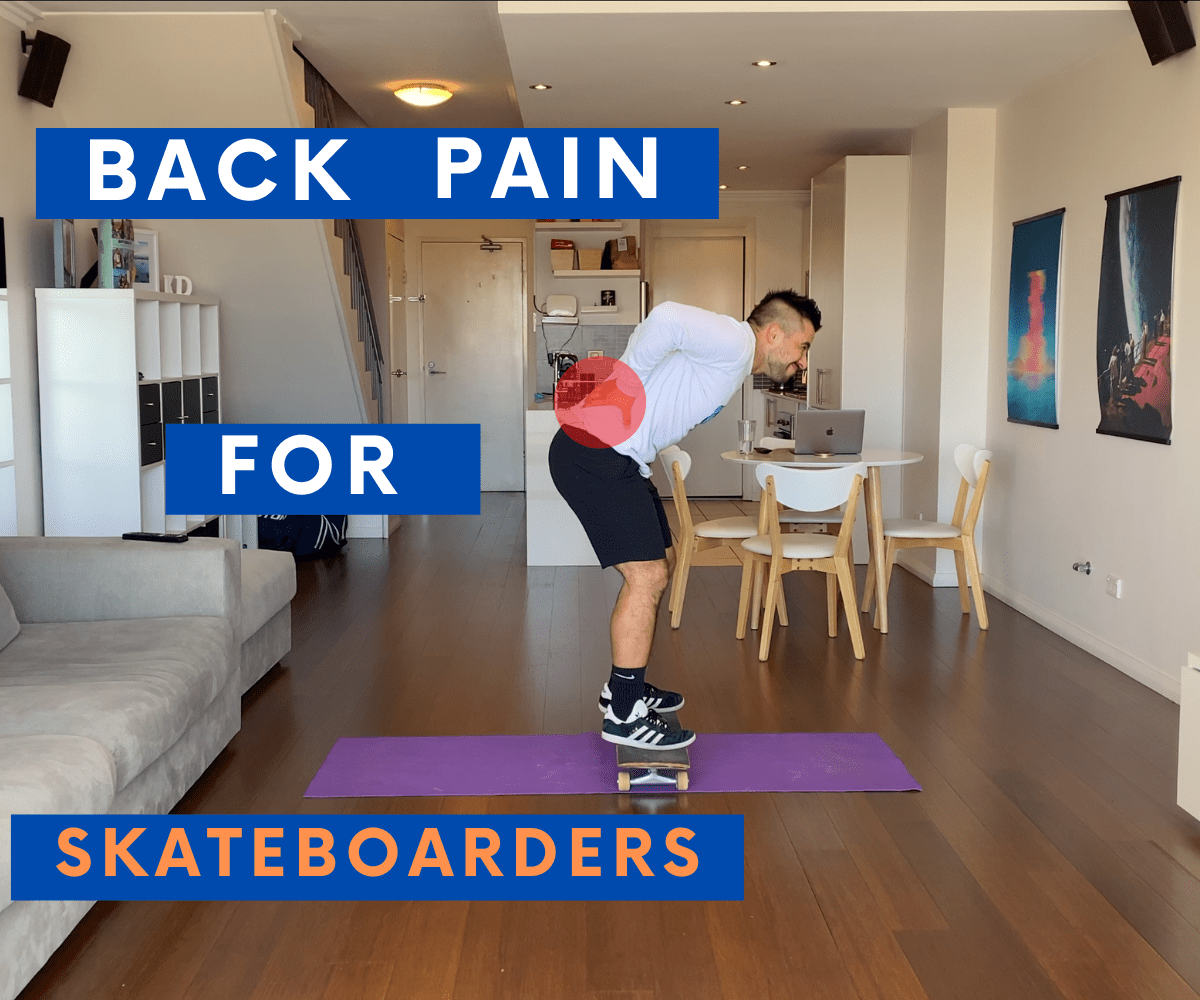Back Pain for Skateboarders: How to assess and treat skate related back pain.
If you skate, at some point in your board career there’s a high possibility of you experiencing back pain, so it’s important to know how to spot it, understand the causes and know how to find a solution. In this article we aim to shed light on skate related back and to learn more about supporting rotation, flexion and extension and core strength to eliminate back pain on the board.
Rotation.
The first thing we are going to look at when we talk back pain for skaters is our ability to rotate. Rotation is huge for skaters when we think about the ability to look over our shoulder on our boards as well as performing rotational tricks. The thoracic spine, or T spine, is the area of our spine that is designed for rotation and where we want to get the majority of our rotation from. When we lack the ability to rotate from our T spine, it often results in us trying to cheat the movement from the lower back (lower lumbar or ‘SI joint’) which tends to get irritated from being pushed too far into rotation causing a lower back pain feeling skaters often complain about.
A really simple test you can do at home to test appropriate rotation is as follows:
- Sit in a chair with both knees together.
- Place a broom handle or rod across your upper chest, pressing lightly on your neck, and cross your hands over to hold it in place.
- Test your rotation by turning slowly and deliberately to both sides, keeping your hips square, feet on the ground and bum on the seat.
- Notice any severe restrictions in mobility or any differences from one side to the other.
- A severe restriction in mobility at the t-spine will be indicated by your ability to get the end of the rod/broom in to the blue ‘pass’ area.
Example of failed test:
Example of passed test :
Restrictions in rotation and range of motion can be restored with the following simple exercise:
- Lie on the floor with a pillow or foam roller propping your head and neck up.
- Turn to the side, ensuring your knees are bent and touching. Extend your bottom arm out.
- Open up your chest by turning slowly, tracing your top arm across your chest and out to the opposite side. Your knees should stay still and together, with your bottom knee pressing into the ground.
- Notice when your bottom knee leaves the ground. This dictates your range of motion.
Flexion and Extension.
Another role of the T spine is flexing and extending of the spine. What we tend to see with skaters is due to constantly adopting a flexed position when skating which allows us to effectively look down at our boards it often limit’s the T spine’s opposite job of achieving full extension, leading to pain or irritation in the lower back (lumbar spine) as this area try’s to take over to cheat the movement. When this happens, the pelvis rolls forward to lock out the lower spine, which puts us in bad positions for absorbing loads from landings from even simple tricks like ollies.
To test mobility in your T spine at home, try the following assessment:
- Stand up straight with a broom handle or rod at your back, held with one hand above your bum
- Create 3 points of contact with the rod; bum, middle of the shoulder blades and the back of your head.
- Notice the gap between your bottom hand and your back. To close it up and achieve a neutral spine position, tuck your pelvis under.
- Maintain this position and lift your chest to extend the middle and upper spine.
- Notice when your pelvis tips forward, or the rod leaves your body in any of the 3 positions. This dictates your range of extension.
Fail: cheating movement by using lower back (red) instead of picking chest up from the thoracic spine (orange)
Pass: maintaining neutral spine by keeping contact with rod hand and lower back (blue) as you use the thoracic spine (orange) to pick the chest up.
Mobility in extension of the T spine can be restored with the following simple exercise:
- Lie on the ground with a foam roller placed across your body, just underneath your shoulder blades,
- Keep your head off the floor and cross your hands behind your head to support the neck.
- Take a big breath in and relax backwards, unrolling your body over the foam roller as you exhale.
- Be aware of forcing the movement or over-arching your back, only going down as much as your mobility allows.
Core Strength.
Skating places a huge demand on the core to brace and protect the spine through a variety of situations, movements and tricks. Bracing effectively means that the spine is protected throughout these movements and the load is being absorbed by the supporting muscles of the core, rather than the extreme locking out of the bones of the spine. This is one way lack of core support for skaters can lead to irritation or unnecessary pain in the back. The other is that the core muscles themselves simply are not strong enough to deal with the extreme demands being placed on them when we skate , so in turn themselves become tired and irritated.
With the importance of a strong core laid out, lets now look at some basic skate specific core exercises that I believe to be the base level of entry for every skater.
To test the characteristics of your core, try the following exercises at home, ensuring you can,
- Perform the full movement slowly and deliberately,
- Complete the required number of repetitions and sets.
If you struggle with any of the below exercises, work on the movement each day until you can achieve the above.
- Dead Bug:
In order to teach us how to effectively brace, breath and move our limbs independently as expressed when skating , the dead bug is a simple, great all-rounder:
- Lie on your back. Bend your knees so your calves are in line with the floor and your knees are above your hips.
- Extend your arms, keeping them in line with your shoulders.
- Tuck your pelvis under to flatten your back against the floor.
- Exhale and move slowly, moving the left arm back and extending the right leg down towards the ground.
- Stop the movement if your back comes off the floor or if you hold your breath. This dictates the limit of your core ability.
- Move the limbs back up to the starting position and repeat with the opposite arm and leg.
- Perform for 3 rounds of 10 repetitions.
- Side Bridge:
The side bridge will be our go-to exercise for resisting the urge to collapse sideways and ensuring controlled movements. (Lateral flexion)
- Lie on your side with your bottom leg bent and thighs together. Bend the bottom arm and place your elbow on the ground underneath your shoulder.
- Push up on the elbow and knee to create a straight line between your knees, hips and shoulders.
- Hold for 30 seconds, ensuring steady breathing and good core tension. If you can’t then slowly work up to being able to hold for this long
- Repeat on the other side and go back and forth for 3 rounds.
- Notice when you begin to slump, hold your breath or lose balance. This indicates when to relax.
- Bird Dog:
For anti rotation we are going to perform the bird dog.
- Start on all fours on the ground, with your knees directly under your hips and your hands positioned under your shoulders.
- Tuck your pelvis under to achieve a neutral spine position before starting the movement.
- Extend your left arm and right leg out simultaneously, creating a straight line between your hand and foot.
- Hold this position for seconds, ensuring steady breathing and a continuous neutral spine.
- Lower slowly and repeat on the opposite side.
- Perform 10 repetitions for 3 rounds.
So there we have it; some simple strategies to begin to asses, understand and treat back pain when you skate. It’s important to note that these exercises should be a base level treatment for dealing with the demands placed on the back from basic skating. If you are an advanced skater, these exercises will still be a great start in eliminating your back pain but you may find that the demands placed on your back when skating exceed the benefits gained with these exercises. In this case, progress and advance these exercises with the variations on the Skateboard Strength Instagram page.
If you want this program delivered in a fully interactive app be sure to get it as part to the Skate Injury Masterclass for free when you join the Ultimate Skate Performance Program. Check it out 👊🏼

